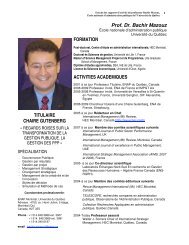Why do firms both make and buy? An investigation of concurrent ...
Why do firms both make and buy? An investigation of concurrent ...
Why do firms both make and buy? An investigation of concurrent ...
Create successful ePaper yourself
Turn your PDF publications into a flip-book with our unique Google optimized e-Paper software.
290 A. Parmigiani<br />
that uncertainty consists <strong>of</strong> a number <strong>of</strong> distinct<br />
constructs, such as dem<strong>and</strong> unpredictability, environmental<br />
volatility, <strong>and</strong> measurement difficulty<br />
(Sutcliffe <strong>and</strong> Zaheer, 1998; Leiblein <strong>and</strong> Miller,<br />
2003; David <strong>and</strong> Han, 2004). A better underst<strong>and</strong>ing<br />
<strong>of</strong> how each <strong>of</strong> these types <strong>of</strong> uncertainty<br />
affects the sourcing decision can be reached by<br />
exploring separate hypotheses for each.<br />
Volume uncertainty is one type <strong>of</strong> environmental<br />
uncertainty that should affect the sourcing decision.<br />
This uncertainty refers to unpredictability <strong>of</strong><br />
dem<strong>and</strong> <strong>and</strong> an accompanying inability to accurately<br />
forecast <strong>and</strong> schedule production. Volume<br />
uncertainty will <strong>make</strong> it more difficult to contract<br />
with suppliers since volume requirements will<br />
directly affect their costs, which will generally<br />
be lower when volume is smooth <strong>and</strong> predictable<br />
(Pindyck <strong>and</strong> Rubenfeld, 1995). Volume uncertainty<br />
will also lead to more misunderst<strong>and</strong>ings<br />
<strong>and</strong> inventory coordination problems, increasing<br />
the need to communicate <strong>and</strong> impede adaptation<br />
(Williamson, 1985); thus, <strong>firms</strong> will produce more<br />
<strong>of</strong> their requirements internally in this situation.<br />
In addition, suppliers will be less likely to invest<br />
in process improvements since fluctuating volumes<br />
will complicate the pay-<strong>of</strong>fs from such investments.<br />
Following this logic, <strong>concurrent</strong>ly sourced<br />
goods will be characterized by moderate levels<br />
<strong>of</strong> volume uncertainty. Restated, this is the next<br />
hypothesis:<br />
Hypothesis 2tce: The greater the good’s volume<br />
uncertainty, the higher the percentage <strong>of</strong><br />
its requirements the firm will produce internally.<br />
Therefore, goods with moderate levels <strong>of</strong> volume<br />
uncertainty will be <strong>concurrent</strong>ly sourced.<br />
<strong>An</strong>other type <strong>of</strong> environmental uncertainty that<br />
can affect a firm’s sourcing decision is when the<br />
technological future is uncertain. The TCE literature<br />
is split on whether greater technological<br />
uncertainty will promote internalization or outsourcing<br />
(Mahoney, 1992). On one h<strong>and</strong>, greater<br />
technological change will result in more significant<br />
adaptation <strong>and</strong> coordination challenges, leading to<br />
a higher degree <strong>of</strong> internalization (Williamson,<br />
1985). However, significant technological uncertainty<br />
will also raise the risk <strong>of</strong> obsolescence <strong>and</strong><br />
therefore <strong>firms</strong> would prefer to not invest, letting<br />
suppliers take this risk instead (Balakrishnan <strong>and</strong><br />
Wernerfelt, 1986). Moreover, technological uncertainty<br />
can drive the firm away from internalization<br />
<strong>and</strong> away from outsourcing, complicating a<br />
TCE prediction which is based upon a continuum<br />
(Poppo <strong>and</strong> Zenger, 1998). Empirical findings have<br />
also been mixed (Rindfleisch <strong>and</strong> Heide, 1997).<br />
Therefore, no TCE hypothesis will be made for<br />
this variable.<br />
Performance uncertainty, or measurement difficulty,<br />
also affects a firm’s sourcing decision. This<br />
uncertainty refers to the difficulty in predicting<br />
how a good will perform in the firm’s subsequent<br />
production processes. The firm will have<br />
an information disadvantage relative to its potentially<br />
opportunistic suppliers if it knows little about<br />
upstream processes (Alchian <strong>and</strong> Demsetz, 1972;<br />
Barzel, 1982). Performance uncertainty will be<br />
greater for more complex goods, especially those<br />
that involve multiple components <strong>and</strong> technologies,<br />
since complexity increases the difficulty in<br />
evaluating quality through inspection prior to use<br />
(Coles <strong>and</strong> Hesterly, 1998; Bensaou <strong>and</strong> <strong>An</strong>derson,<br />
1999; Novak <strong>and</strong> Eppinger, 2001). If quality<br />
is difficult to evaluate, then monitoring a supplier’s<br />
compliance will be problematic, as will determining<br />
when to enforce sanctions. TCE logic suggests<br />
that greater internalization will solve these<br />
monitoring problems <strong>and</strong> remove the potential for<br />
supplier opportunism, since the firm’s hierarchical<br />
structure will improve information flows <strong>and</strong><br />
coordinate incentives. Thus, <strong>concurrent</strong>ly sourced<br />
goods would have a moderate level <strong>of</strong> performance<br />
uncertainty. These arguments support the<br />
final TCE-based hypothesis:<br />
Hypothesis 3tce: The greater the performance<br />
uncertainty <strong>of</strong> the good, the higher the percentage<br />
<strong>of</strong> its requirements the firm will produce<br />
internally. Goods with a moderate level<br />
<strong>of</strong> performance uncertainty will be <strong>concurrent</strong>ly<br />
sourced.<br />
Neoclassical economics <strong>and</strong> <strong>concurrent</strong><br />
sourcing<br />
The st<strong>and</strong>ard neoclassical economic explanation<br />
for <strong>concurrent</strong> sourcing involves hedging against<br />
dem<strong>and</strong> uncertainty. In this case, a firm can keep<br />
its internal plant at full production by using suppliers<br />
to h<strong>and</strong>le fluctuating additional volumes,<br />
thereby running more efficiently due to having<br />
this flexibility in capacity (Adelman, 1949; Carlton,<br />
1979; Porter, 1980). This position assumes a<br />
Copyright © 2007 John Wiley & Sons, Ltd. Strat. Mgmt. J., 28: 285–311 (2007)<br />
DOI: 10.1002/smj





